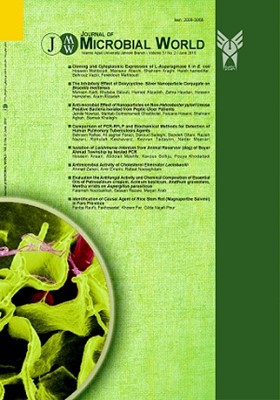Cloning and Cytoplasmic Expression of L-Asparaginase II in E. coli
Subject Areas : Microbial BiotechnologyHossein Mahboudi 1 , Mansour Abachi 2 , Shahram Araghi 3 , Haleh Hamedifar 4 , Behrouz Vaziri 5 , Fereidoun Mahboudi 6 *
1 - Department of Microbiology, Qom Branch, Islamic Azad University, Qom, Iran
2 - Department of Research and Development, CinnaGen Co., Tehran, Iran
3 - Department of Research and Development, CinnaGen Co., Tehran, Iran
4 - Department of Research and Development, CinnaGen Co., Tehran, Iran
5 - Biotechnology Research Center, Protein Chemistry Unit, Pasteur Institute of Iran, Tehran, Iran
6 - Biotechnology Research Center, Recombinant Protein Unit, Pasteur Institute of Iran, Tehran, Iran
Keywords: Escherichia coli, Cloning, Gene expression, L-Asparaginase II,
Abstract :
Background and objectives: L-Asparaginase (isozyme II) is a natural product of E. coli that possesses an antitumor activity. This enzymeis used for treating acute lymphoblastic leukemia (ALL). The aim of this study was to clone of the corresponding gene without signal peptide and also without first methionine as well as to express the gene in cytoplasm. Materials and Methods: The L-Asparaginase gene was isolated by PCR from E. coli K12 strain and cloned into engineered expression vector pET32. Sequencing and evaluation of gene expression were done by routine procedure. Methionine amino peptidase containing recombinant plasmid was purified and transferred into recombinant asparaginase producing bacterium by heat shock method. Results: The majority of L-asparaginase was expressed in cytoplasm. Based on high expression of methionine amino peptidase enzyme in E. coli Origami, it was expected that the first methionine of L-asparaginase has been removed efficiently. Conclusion: According to the achieved results, the recombinant bacterium with extensive ability to express cytoplasmic recombinant L-asparaginase is an ideal candidate for industrial production of L-asparaginase.
1. Kotzia GA, Labrou NE. L-Asparaginase from Erwinia chrysanthemi 3937: cloning, expression and characterization. J. Biothechnol. 2007; 127: 657-669.
2. Aghaiypour K, Wlodawer A, Lubkowski J. Do bacterial L-asparaginase utilize a catalytic triad Thr-Tyr-Glu?. J. Biochem. Biophys. Acta. 2001; 1550: 117-128.
3. Aghaiypour K, Wlodawer A, Lubkowski J. Structural basis for the activity and substrate specificity of Er. chrysanthemi L- asparaginase. J. Biochem. 2001; 40: 5655-5664.
4. Afrasiabi R, Aghaiypour K, Kafilzadeh F, Safaviyeh S. Cloning, sequence analysis, and expression of L-asparaginase obtained from Erwinia chrysanthemi. Jouenal of Microbial World. 2010; 3(1): 7-15.
5. Lubkowski J, Palm G, Gilliland Gary L, Derst CH, Rohm K, wlodawer A. Crystal structure and amino acid sequence of Wolinella succinogenes L-asparaginase. J. Biochem. 1996; 241: 201-207.
6. Harms E, Wehner A, Aung HP٫ Rohm KH. A catalytic role for threonine-12 of E.coli asparaginaseII as established by site-directed mutagenesis. FEBS. 1991; 285: 55-58.
7. Ferrara MA, Severino NMB, Mansure JJ, Martins AS, Oliveira EMM, Siani AC, Pereira N, Torres FAG, Bon EPS. Asparaginase production by a recombinant Pichia pastoris strain harbouring Saccharomyces cervisiae Asp3 gene. Enzyme Microb. Tech. 2006; 39: 1457-1463.
8. Youssef MM, Al-Omair MA. Cloning, purification, characterization and immobilization of l-asparaginase II from E. coli W3110. Asian J. Biochem. 2008; 3 (6): 337-350.
9. Ward KR, Adams GDJ, Alpar HO, Irwin WJ. Protection of the enzyme L-asparaginase during lyophilisation–a molecular modelling approach to predict required level of lyoprotectant. J. Pharmaceutics. 1999; 187: 153-162.
10. Zhang YQ, Zhou WL, Shen WD, Chen YH, Zha XM, Shirai K, Kiguchi K. Synthesis, characterization and immunogenicity of silk fibroin–L-asparaginase bioconjugates. J. Biotechnol. 2005; 120: 315-326.
11. Rusel D, Sambrook J. Molecular cloning A laboratory Manual. Third edition ٫Cold Spring Harbor Laboratory Press, 2001.
12. Nakahama K, Imada A, Igarasi S, Tubaki K. Formation of L-Asparaginase by Fusarium Species J Gen Microbiol. 1973; 75: 269-273.
13. Jennings MP, Beacham IR. Analysis of the Escherichia coli gene encoding L-asparaginase II ansB and its regulation by cyclic AMP receptor and FNR proteins. J. Bacteriol. 1990; 172: 1491-1498.
14. Jeristrom PG, Liu J, Beacham IR. Regulation of E. coli l-asparaginase II and 1-aspartaseby the fnr gene product. FEMS Microbiol. Lett. 1989; 41: 127-130.
15. Roberts J, Bursonand G, Hill JM. New procedures for purification of L-asparaginase with high yield from Escherichia coli. J. Bacteriol. 1968; 95: 2117-2123.
16. Khushoo A, Pal Y, Singh BN, Mukherjee KJ. Extracellular expression and single step purification of recombinant Escherichia coli L-asparaginase II. Protein Expression Purificat. 2004; 38: 29-36.
17. Avramis VI, Panosyan EH. Pharmacokinetic/pharmacodynamics relationships of asparaginase formulations: The past, the present and recommendations for the future. Clin. Pharmacokinet. 2005; 44: 367-393.
18. Verma N, Kumar K, Kaur G, Anand S. L-asparaginase: A promising chemotherapeutic agent. Crit. Rev. Biotechnol. 2007; 27: 45-62.
19. Maita T, Morokuma K, Mastuda G. Amino acid sequence of L-asparaginase from E.coli. J. Biochem. 1974; 76: 1351-1354.
20. Corena CP, Lupescu I, Vatafu I, Caraiani T, Savoiu VG, Campeanu GH, Grebenisan I, Negulescu GHP, Constantinescu D. Production of L-asparaginase II by recombinant Escherichia coli cells. Roum. Biotechnol. Lett. 2002; 7(3): 717-772.

